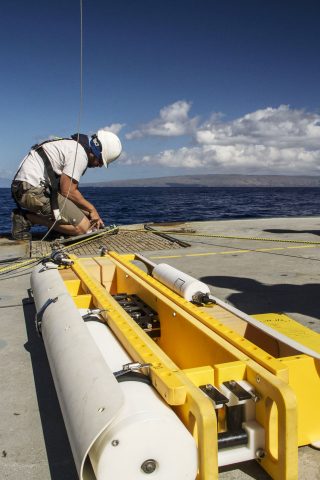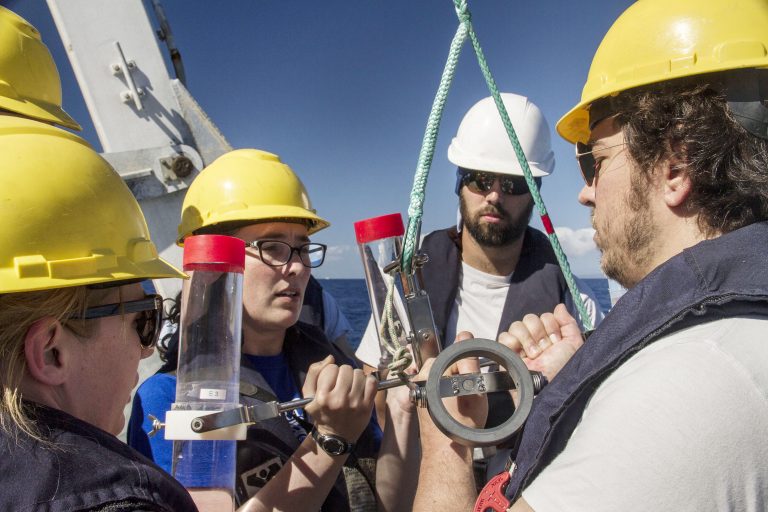The weather is perfect as oceanographer Melissa Omand stands on Falkor’s aft deck overseeing the deployment of her treasured Wirewalker. The sophisticated instrument is designed to take numerous measurements from the water column while capturing particles falling into the deep ocean as the technology moves up and down a 150 meter-long wire. The waves around the ship are barely half a meter high, which is great news for Melissa, as this is only the third time she has deployed the walker, and the first time to do so using the type of winch on Falkor. Keeping an eye on the cable, she swiftly attaches weights and sediment traps at specific breaks of the line, then watches them all sink deeper by the second.
The continuous buzz of preparations over the past few weeks has begun to settle into a plan that will be fulfilled over the next four weeks. That buzz is precisely the favorite part of research expeditions for Ivona Cetinić, Chief Scientist.
Orchestra Director
Ivona sees opportunities in chaos, a crucial trait for the leader of an expedition with multiple moving parts. Many scientific disciplines have all come together to better understand which particles are responsible for the different colors of seawater, as well as the biochemical and physical processes behind the particles’ presence and life-cycles. The scientists will also test and confirm the accuracy of satellites identifying these colors from space. To do so, they have come on board carrying a wide array of instrumentation, all of which needs to play a cohesive melody under Ivona’s direction. Her strategy is to control chaos by repetition.


Slow and Steady
Repetition works for Philipp Gunther. After almost four years as Chief Mate of Falkor and three expeditions as Captain, it is fair to say that he is familiar with the process of deploying equipment off the ship. Still, before Falkor has reached her first scientific station, he makes sure everyone is on the same page by running trial exercises. “It is like driving cars,” he says. “All people think they understand how it is done, but if you don’t make sure they are all in agreement about the rules, safe and efficient traffic would be impossible”.
A “tool box talk” enables the participants to get familiar with the instrument and all its components. All questions are answered and Phil carefully selects a limited number of participants in order to minimize the risk of injury. He pays close attention as the A-frame lowers the Wirewalker into the ocean, watching over the people involved more than the instrument itself, he confesses. His priority is the safety of everyone involved. All precautions pay off, and Phil is satisfied with the completed, controlled, and successful operation.
Blood, Sweat and Tears
Melissa attributes the “blood, sweat and tears” that have gone into both the instruments and the preparation as the key ingredients that make today’s exercise a success. She is deeply appreciative of the crew’s expertise and their openness to let her not only participate, but take charge.
It was a year ago when Ivona confirmed she would conduct her expedition aboard Falkor. Since then things have accelerated to reaching a hyperactive buzz, a worthy price to pay so the researchers can be sure that Falkor would become a fruitful floating laboratory. “Things have lined up,” says Ivona. “We have assembled a team of people that has never worked together before, but the combination of our skills, knowledge and experiments will hopefully render the whole picture of how ocean color works and the connection between sea and space.”


